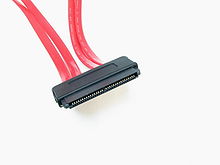Serial attached SCSI
| Serial Attached SCSI | |

SAS connector
|
|
| Width in bits | 1 |
|---|---|
| No. of devices | 65,535 |
| Speed |
|
| Style | Serial |
Serial Attached SCSI (SAS) is a point-to-point serial protocol that moves data to and from computer storage devices such as hard drives and tape drives. SAS replaces the older Parallel SCSI (Parallel Small Computer System Interface, usually pronounced "scuzzy") bus technology that first appeared in the mid-1980s. SAS, like its predecessor, uses the standard SCSI command set. SAS offers backward compatibility with SATA, versions 2 and later. This allows for SATA drives to be connected to SAS backplanes. The reverse, connecting SAS drives to SATA backplanes, is not possible.
The T10 technical committee of the International Committee for Information Technology Standards (INCITS) develops and maintains the SAS protocol; the SCSI Trade Association (SCSITA) promotes the technology.
A typical Serial Attached SCSI system consists of the following basic components:
A SAS Domain is the SAS version of a SCSI domain—it consists of a set of SAS devices that communicate with one another by means of a service delivery subsystem. Each SAS port in a SAS domain has a SCSI port identifier that identifies the port uniquely within the SAS domain, the World Wide Name. It is assigned by the device manufacturer, like an Ethernet device's MAC address, and is typically worldwide unique as well. SAS devices use these port identifiers to address communications to each other.
In addition, every SAS device has a SCSI device name, which identifies the SAS device uniquely in the world. One doesn't often see these device names because the port identifiers tend to identify the device sufficiently.
For comparison, in parallel SCSI, the SCSI ID is the port identifier and device name. In Fibre Channel, the port identifier is a WWPN and the device name is a WWNN.
In SAS, both SCSI port identifiers and SCSI device names take the form of a SAS address, which is a 64 bit value, normally in the NAA IEEE Registered format. People sometimes refer to a SCSI port identifier as the SAS address of a device, out of confusion. People sometimes call a SAS address a World Wide Name or WWN, because it is essentially the same thing as a WWN in Fibre Channel. For a SAS expander device, the SCSI port identifier and SCSI device name are the same SAS address.
...
Wikipedia
